
Nina Simone was an American singer, songwriter, pianist, composer, arranger, and civil rights activist. Her music spanned styles including classical, folk, gospel, blues, jazz, R&B, and pop. Her piano playing was strongly influenced by baroque and classical music, especially Johann Sebastian Bach, and accompanied expressive, jazz-like singing in her contralto voice.
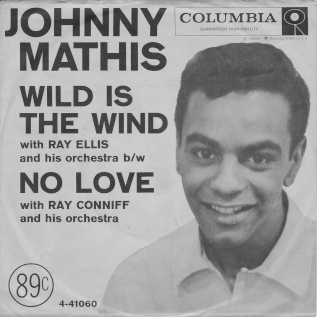
"Wild Is the Wind" is a song written by Dimitri Tiomkin and Ned Washington for the 1957 film Wild Is the Wind. Johnny Mathis recorded the song for the film and released it as a single in November 1957. Mathis' version reached No. 22 on the Billboard chart. It was nominated for an Academy Award for Best Song in 1958, but lost to "All the Way" by Jimmy Van Heusen and Sammy Cahn from The Joker is Wild.
"Feeling Good" is a song written by English composers Anthony Newley and Leslie Bricusse for the musical The Roar of the Greasepaint – The Smell of the Crowd. It was first performed on stage in 1964 by Cy Grant on the UK tour.
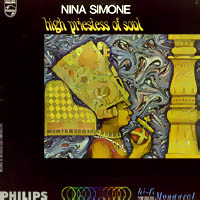
High Priestess of Soul is a studio album by singer, pianist and songwriter Nina Simone. The songs are accompanied by a large band directed and arranged by Hal Mooney. The album contains pop songs and African American gospel and folk-related songs written by Simone herself. After this album title – an attempt to broaden her appeal by management execs – Nina Simone was sometimes titled “the high priestess of soul”, although she completely rejected the title herself because it placed a label on her as an artist. However, according to her daughter, Lisa, she never hated that moniker.

Baltimore is the fourteenth studio album by American singer-songwriter and pianist Nina Simone, released in January 1978 by CTI Records. Due to a lack of promotion, and Simone's dissatisfaction with the record, It became a commercial failure, failed to chart, and also received mixed reviews from critics. It would also become her first and only album released under her contract with CTI Records. The title track was originally written and recorded by Randy Newman in 1977.

Sings the Blues is an album by singer/pianist/songwriter Nina Simone. This was Simone's first album for RCA Victor after previously recording for Colpix Records and Philips Records. The album was also reissued in 2006 with bonus tracks, and reissued in 1991 by RCA/Novus as a 17-track compilation under the title The Blues.
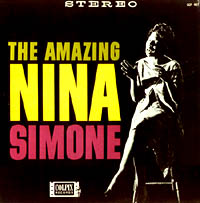
The Amazing Nina Simone is the second studio album by Nina Simone, released in July 1959. It was her second album, and her first recording for Colpix Records. The album contains a variety of material, including jazz, gospel, and folk songs. Compared to her debut, which showcased Simone's piano playing ability in addition to her singing, the piano was downplayed on Amazing in favor of string arrangements.

Nina Simone and Her Friends is an album released in 1960 by the Bethlehem Records label, that compiled songs by jazz singers Nina Simone, Carmen McRae and Chris Connor. All three artists had left the label and signed with other companies by the time Bethlehem released this album. The numbers by Simone - with the exception of her 1959 hit single "I Loves You, Porgy" were "left overs" from the recording sessions for her 1959 debut album Little Girl Blue and released without her knowledge. The tracks by Connor and McRae had already been issued together this way, as Bethlehem's Girlfriends, in 1956, accompanied by the debut recording session of Julie London.

Nina Simone at Town Hall is the first live album by Nina Simone, released in December 1959. It was her third album of that year, her second album for Colpix Records, and her first live album. The basis for the record was Simone's performance at the Town Hall, New York, on 12 September 1959. All of the songs performed at the concert are on the album; however, three of the tracks are studio versions cut the following month.

Nina Simone at Newport is a live album by jazz singer and musician Nina Simone. It was released in August 1960; the recording taken from a concert held at the Newport Jazz Festival earlier in the year, on 30 June 1960. The album was her fourth overall, and her third for Colpix; it was also her second live album, following on from Nina Simone at Town Hall (1959) released at the end of the previous year. All arrangements on Nina Simone at Newport were written by Simone, and it was produced by Stu Phillips.

Forbidden Fruit is the third studio album by Nina Simone. It was her second studio album for Colpix. The rhythm section accompanying her is the same trio as on both live albums before and after this release.
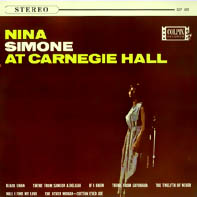
Nina Simone at Carnegie Hall is a 1963 album by jazz singer/pianist/songwriter Nina Simone. It is a live album recorded at Simone's first solo appearance at Carnegie Hall in New York City, on April 12, 1963, and was released on Colpix Records. The recording was made by Richard Alderson, who had previously recorded the album Nina Simone at The Village Gate, and who also worked as Nina Simone's live sound engineer during this period.

I Put a Spell on You is a studio album by American jazz singer, songwriter, and pianist Nina Simone. Recorded in 1964 and 1965 in New York City, it was released by Philips Records in 1965. It peaked at number 99 on the Billboard 200 chart and number 18 on the UK Albums Chart. The title track "I Put a Spell on You" peaked at number 23 on the Hot Rhythm & Blues Singles chart and number 28 on the UK Singles Chart.

Little Girl Blue: Jazz as Played in an Exclusive Side Street Club is the debut studio album by Nina Simone. Recorded in late 1957, it was eventually released by Bethlehem Records in February 1959. Due to the length of time the album had taken to be released and the lack of any promotional single either immediately before or alongside the album, Simone would become disillusioned with Bethlehem and sign with Colpix Records in April 1959. She recorded the tracks for her second album – what would become The Amazing Nina Simone – the same month. However, in May Bethlehem finally released a single, "I Loves You, Porgy" and gave Simone her first hit later that year, peaking at number 18 on the pop charts, and number 2 on the R&B charts. Helped by the profile of the single, the album too went on to become a chart success.
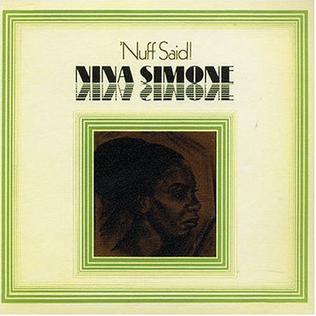
'Nuff Said! is an album by jazz singer/pianist/songwriter Nina Simone. It was recorded—excluding tracks 1, 8, and 11—at Westbury Music Fair, April 7, 1968, three days after the murder of Martin Luther King Jr. The whole program that night was dedicated to his memory. The album featured one of Simone's biggest hits in Europe, "Ain't Got No, I Got Life".

"Mississippi Goddam" is a song written and performed by American singer and pianist Nina Simone, who later announced the anthem to be her "first civil rights song". Composed in less than an hour, the song emerged in a “rush of fury, hatred, and determination” as she "suddenly realized what it was to be black in America in 1963." The song was released on her album Nina Simone in Concert in 1964, which was based on recordings from three concerts she gave at Carnegie Hall earlier that year. The album was her first release for the Dutch label Philips Records and is indicative of the more political turn her recorded music took during this period.
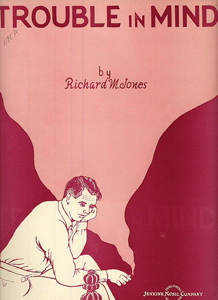
"Trouble in Mind" is a vaudeville blues-style song written by jazz pianist Richard M. Jones. Singer Thelma La Vizzo with Jones on piano first recorded it in 1924 and in 1926, Bertha "Chippie" Hill popularized the tune with her recording with Jones and trumpeter Louis Armstrong. The song became an early blues standard, with numerous renditions by a variety of musicians in a variety of styles.

Nina is a Nina Simone tribute album by Xiu Xiu. It was released on Graveface Records on December 3, 2013, to generally favorable reviews.
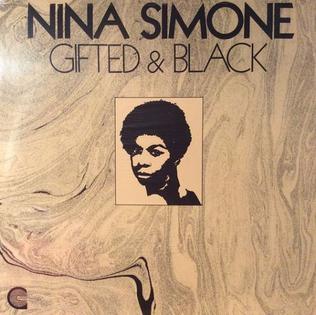
Gifted & Black is an unofficial studio album from jazz singer, pianist, and songwriter Nina Simone. It was originally released in 1970 by Canyon Records. However, it is thought to be a demo tape made by Simone in the spring of 1957 some months before the recording of Little Girl Blue, her first official album, in December of the same year. For the release in 1970, the original recording had strings added.
Richard Larm Alderson is an American audio engineer and record producer, who has worked on recordings by Nina Simone, Bob Dylan, Harry Belafonte, Sun Ra, The Fugs, Pearls Before Swine, Roberta Flack, Grover Washington Jr. and others.


















